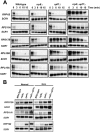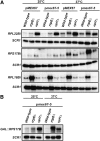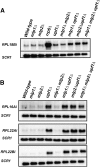Sequential RNA degradation pathways provide a fail-safe mechanism to limit the accumulation of unspliced transcripts in Saccharomyces cerevisiae
- PMID: 22753783
- PMCID: PMC3404376
- DOI: 10.1261/rna.033779.112
Sequential RNA degradation pathways provide a fail-safe mechanism to limit the accumulation of unspliced transcripts in Saccharomyces cerevisiae
Abstract
The nuclear exosome and the nonsense-mediated mRNA decay (NMD) pathways have been implicated in the degradation of distinct unspliced transcripts in Saccharomyces cerevisiae. In this study we show that these two systems can act sequentially on specific unspliced pre-mRNAs to limit their accumulation. Using steady-state and decay analyses, we show that while specific unspliced transcripts rely mostly on NMD or on the nuclear exosome for their degradation, some unspliced RNAs are stabilized only when both the nuclear exosome and NMD are inactivated. We found that the mechanism of degradation of these unspliced pre-mRNAs is not influenced by promoter identity. However, the specificity in the pre-mRNAs degradation pathways can be manipulated by changing the rate of export or retention of these mRNAs. For instance, reducing the nuclear export of pre-mRNAs mostly degraded by NMD results in a higher fraction of unspliced transcripts degraded by the nuclear exosome. Reciprocally, inactivating the Mlp retention factors results in a higher fraction of unspliced transcripts degraded by NMD for precursors normally targeted by the nuclear exosome. Overall, these results demonstrate that a functional redundancy exists between nuclear and cytoplasmic degradation pathways for unspliced pre-mRNAs, and suggest that the degradation routes of these species are mainly determined by the efficiency of their nuclear export rates. The presence of these two sequential degradation pathways for unspliced pre-mRNAs underscores the importance of limiting their accumulation and might serve as a fail-safe mechanism to prevent the expression of these nonfunctional RNAs.
Figures





Similar articles
-
Nuclear mRNA Quality Control and Cytoplasmic NMD Are Linked by the Guard Proteins Gbp2 and Hrb1.Int J Mol Sci. 2021 Oct 19;22(20):11275. doi: 10.3390/ijms222011275. Int J Mol Sci. 2021. PMID: 34681934 Free PMC article. Review.
-
Widespread impact of nonsense-mediated mRNA decay on the yeast intronome.Mol Cell. 2008 Aug 8;31(3):360-70. doi: 10.1016/j.molcel.2008.07.005. Mol Cell. 2008. PMID: 18691968 Free PMC article.
-
Unspliced precursors of NMD-sensitive β-globin transcripts exhibit decreased steady-state levels in erythroid cells.PLoS One. 2012;7(6):e38505. doi: 10.1371/journal.pone.0038505. Epub 2012 Jun 4. PLoS One. 2012. PMID: 22675570 Free PMC article.
-
Nonsense-containing mRNAs that accumulate in the absence of a functional nonsense-mediated mRNA decay pathway are destabilized rapidly upon its restitution.Mol Cell Biol. 2003 Feb;23(3):842-51. doi: 10.1128/MCB.23.3.842-851.2003. Mol Cell Biol. 2003. PMID: 12529390 Free PMC article.
-
Impact of Methods on the Measurement of mRNA Turnover.Int J Mol Sci. 2017 Dec 15;18(12):2723. doi: 10.3390/ijms18122723. Int J Mol Sci. 2017. PMID: 29244760 Free PMC article. Review.
Cited by
-
The nuclear basket proteins Mlp1p and Mlp2p are part of a dynamic interactome including Esc1p and the proteasome.Mol Biol Cell. 2013 Dec;24(24):3920-38. doi: 10.1091/mbc.E13-07-0412. Epub 2013 Oct 23. Mol Biol Cell. 2013. PMID: 24152732 Free PMC article.
-
Folding Stability of Pax9 Intronic G-Quadruplex Correlates with Relative Molar Size in Eutherians.Mol Biol Evol. 2021 May 4;38(5):1860-1873. doi: 10.1093/molbev/msaa331. Mol Biol Evol. 2021. PMID: 33355664 Free PMC article.
-
Nuclear mRNA Quality Control and Cytoplasmic NMD Are Linked by the Guard Proteins Gbp2 and Hrb1.Int J Mol Sci. 2021 Oct 19;22(20):11275. doi: 10.3390/ijms222011275. Int J Mol Sci. 2021. PMID: 34681934 Free PMC article. Review.
-
Widespread use of non-productive alternative splice sites in Saccharomyces cerevisiae.PLoS Genet. 2014 Apr 10;10(4):e1004249. doi: 10.1371/journal.pgen.1004249. eCollection 2014 Apr. PLoS Genet. 2014. PMID: 24722551 Free PMC article.
-
Global analysis of the nuclear processing of transcripts with unspliced U12-type introns by the exosome.Nucleic Acids Res. 2014 Jun;42(11):7358-69. doi: 10.1093/nar/gku391. Epub 2014 May 21. Nucleic Acids Res. 2014. PMID: 24848017 Free PMC article.
References
-
- Bousquet-Antonelli C, Presutti C, Tollervey D 2000. Identification of a regulated pathway for nuclear pre-mRNA turnover. Cell 102: 765–775 - PubMed
-
- Bregman A, Avraham-Kelbert M, Barkai O, Duek L, Guterman A, Choder M 2011. Promoter elements regulate cytoplasmic mRNA decay. Cell 147: 1473–1483 - PubMed
-
- Chang YF, Imam JS, Wilkinson MF 2007. The nonsense-mediated decay RNA surveillance pathway. Annu Rev Biochem 76: 51–74 - PubMed
Publication types
MeSH terms
Substances
Grants and funding
LinkOut - more resources
Full Text Sources
Molecular Biology Databases
